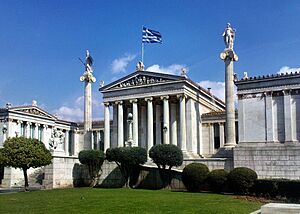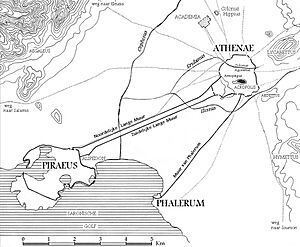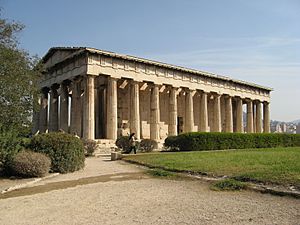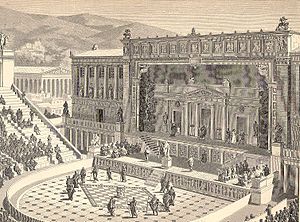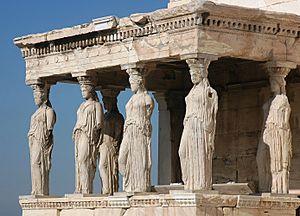Classical Athens facts for kids
Quick facts for kids
Athens
Ἀθῆναι (Ancient Greek)
|
|||||||||
|---|---|---|---|---|---|---|---|---|---|
| 508 BC–322 BC | |||||||||
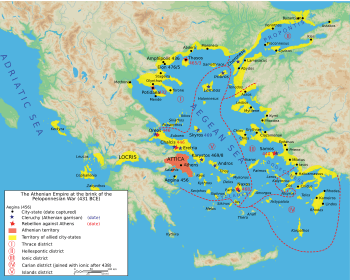
Delian League ("Athenian Empire") shown in yellow, Athenian territory shown in red, situation in 431 BC, before the Peloponnesian War.
|
|||||||||
| Capital | Athens | ||||||||
| Common languages | Attic Greek | ||||||||
| Religion | Greek Polytheism | ||||||||
| Government | Athenian direct democracy | ||||||||
| Eponymous archon | |||||||||
|
• 508–507 BC
|
Isagoras | ||||||||
|
• 322–321 BC
|
Philocles | ||||||||
| Legislature | Boule Ecclesia |
||||||||
| Historical era | Classical antiquity Classical Greece |
||||||||
|
• Cleisthenes establishes Athenian democracy
|
508 BC | ||||||||
| 478–404 BC | |||||||||
|
• Thirty tyrants
|
404–403 BC | ||||||||
|
• Second Athenian League
|
378–355 BC | ||||||||
|
• Lamian War
|
322 BC | ||||||||
| Population | |||||||||
|
• 5th century BC1
|
~250,000 (men with civil rights: ~30,000) | ||||||||
| Currency | Drachma | ||||||||
|
|||||||||
|
1BBC History
|
|||||||||
Classical Athens was a powerful city-state in Ancient Greece. It was the most important city during the classical period (480–323 BC). Athens is famous for its art, philosophy, and for being the birthplace of democracy.
The city was located in Attica, Greece. During its peak, Athens led a group of allies called the Delian League. It often fought against Sparta, another powerful Greek city-state. The most famous leader of Athens was Pericles. He helped make the city beautiful and strong during the "Golden Age."
Athens was home to many famous thinkers and writers. Plato and Aristotle opened schools there. Socrates asked important questions about life. Playwrights like Sophocles wrote plays that are still performed today. Because of these achievements, Athens is often called the "cradle of Western civilization."
Contents
History of Athens
The Beginning of Democracy
Before democracy, Athens was ruled by tyrants (rulers with total power). In 510 BC, the tyrant Hippias was removed from power with the help of Sparta. A leader named Cleisthenes then made big changes. He wanted the people to have a say in how the city was run.
In 508 BC, Cleisthenes created a new system of government. He divided the citizens into ten tribes. This system was not based on how rich someone was. Each tribe chose members for a council called the Boule. This council helped run the city every day. There was also a large meeting called the Assembly. All male citizens could vote there. This was the start of Athenian democracy.
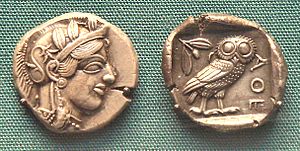
The Persian Wars
In the early 5th century BC, the powerful Persian Empire tried to invade Greece. Athens played a huge role in defending Greece.
In 490 BC, the Athenians defeated the Persians at the Battle of Marathon. Ten years later, the Persians returned with a huge army. The Spartans fought bravely at Thermopylae, but the Persians marched to Athens and burned the city. However, the Athenian navy, led by Themistocles, won a great victory at sea in the Battle of Salamis. This victory saved Greece and made Athens a naval superpower.
The Golden Age of Pericles
After the wars, Athens became very wealthy and powerful. This time is known as the Age of Pericles. Pericles was a general and a popular leader. He used money from the Delian League (an alliance of Greek cities) to rebuild Athens.
Pericles built magnificent buildings, including the Parthenon on the Acropolis. Art, theater, and learning flourished. It was a time of great pride for the Athenians.
War with Sparta
Athens' power made other Greek cities nervous, especially Sparta. In 431 BC, a long conflict called the Peloponnesian War began. It was a fight between the Athenian empire (strong at sea) and the Spartan alliance (strong on land).
The war lasted for many years. Athens suffered from a plague and bad decisions. In 404 BC, Athens was defeated. The city lost its empire and its walls were torn down. Democracy was briefly replaced by a group of rulers called the Thirty Tyrants, but the people soon took power back.
The Rise of Macedon
In the 4th century BC, a new power rose in the north: the kingdom of Macedon. King Philip II defeated Athens and its allies in 338 BC. This ended Athens' time as a fully independent power.
Philip's son, Alexander the Great, went on to conquer a vast empire. After Alexander died, Athens remained a center for culture and education, but it was no longer a military leader.
Geography and City Layout
The Acropolis and Agora

Athens was built around a rocky hill called the Acropolis. This was a fortress and a sacred place. It had many temples, including the famous Parthenon dedicated to the goddess Athena.
Below the Acropolis was the Agora. This was the marketplace and the center of public life. People went there to shop, talk about politics, and meet friends. Important government buildings were also located in the Agora.
Walls and Gates
The city was protected by strong stone walls. The most famous were the Long Walls. These two parallel walls connected the main city of Athens to its port, Piraeus, which was about 7 kilometers away.
The Long Walls were very important during wars. They allowed Athens to get supplies from ships even if an enemy army surrounded the city on land.
Important Buildings
Athens had many beautiful public buildings:
- Temples: Besides the Parthenon, there was the Temple of Hephaestus (which is still standing today) and the huge Temple of Olympian Zeus.
- Theaters: The Theatre of Dionysus was built on the slope of the Acropolis. Thousands of people gathered there to watch plays.
- Gymnasiums: Places like the Lyceum and the Academy were used for exercise and education.
Culture and Learning
Classical Athens was a brilliant center for learning and the arts. Many ideas we use today started there.
- Philosophy: Famous thinkers lived in Athens. Socrates taught people to question everything. His student, Plato, wrote down his ideas and started a school called the Academy. Plato's student, Aristotle, studied nature and science.
- Theater: The Athenians invented drama. They held festivals where playwrights competed. Aeschylus, Sophocles, and Euripides wrote tragedies (serious plays). Aristophanes wrote comedies (funny plays).
- History: Writers like Herodotus and Thucydides wrote down the history of the wars and events of their time.
Images for kids
-
The Acropolis imagined in an 1846 painting by Leo von Klenze
See also
 In Spanish: Antigua Atenas para niños
In Spanish: Antigua Atenas para niños
- Politics
- Archon basileus
- Eponymous archon
- Solonian Constitution
- Society
- Women in classical Athens
- Ancient Greek crafts
- Education
- Ephebic Oath
- Athenian Army



